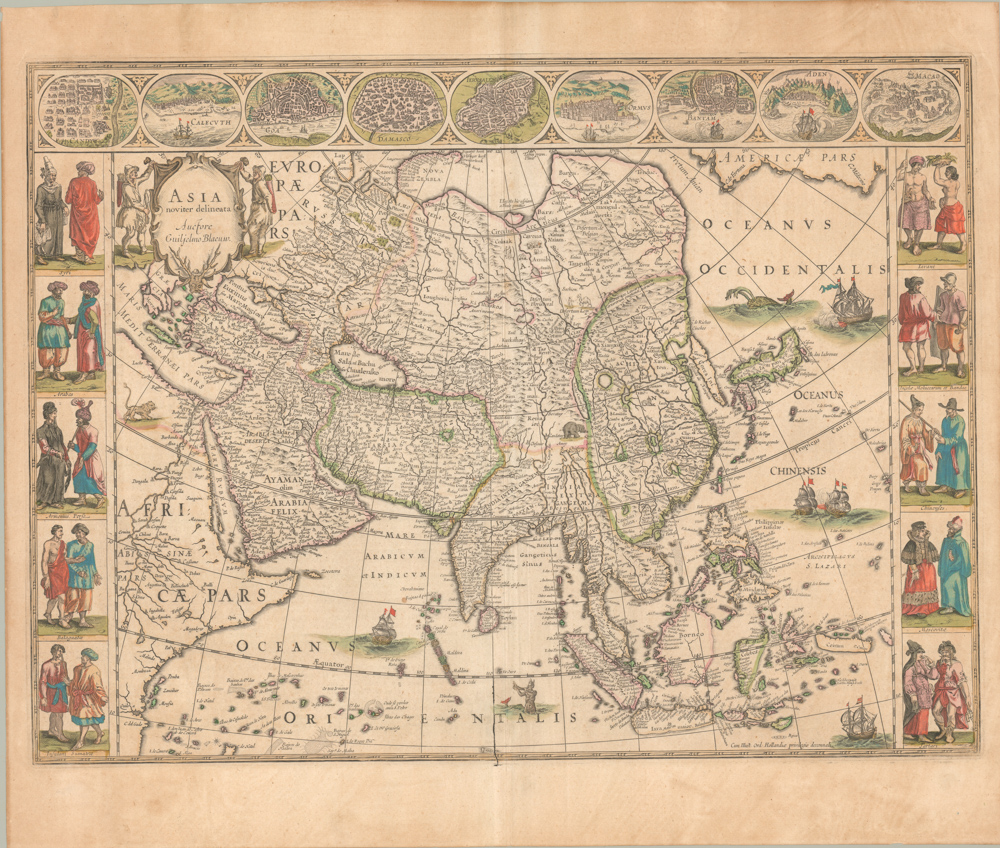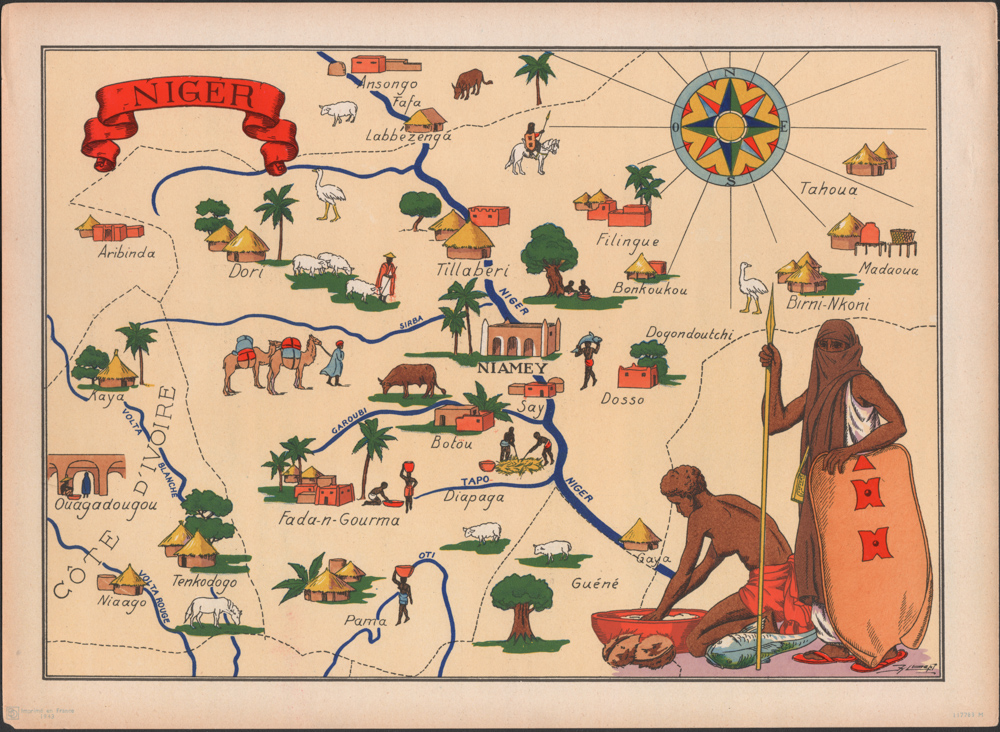De Wit’s Africa triumph in lovely old color.
Novissima et Perfectissima Africae Descriptio
Out of stock
Description
This map of Africa encapsulates why noted cartographer Frederick De Wit’s charts were so popular both in his lifetime and today. Very few late 17th century maps depict the African continent with such meticulous care and attention to detail. Even the great Saharan belt, which remains largely void of human settlement to this day, has been extensively annotated, decorated, and labeled. It is an impressive chart of a continent still largely underestimated by Europeans.
This chart became the late 17th century standard for subsequent Dutch maps of Africa. It was reissued a number of times by other mapmakers such as Danckerts, De Ram, Visscher, and others, and reappeared well into the 18th century.
In addition to the impressive degree of geographic detail throughout the continent, De Wit includes an array of vivid African wildlife scenes, including lions, leopards, rhinos, elephants, monkeys, and ostriches. Yet there are other more esoteric features to note as well.
In general, the map shows an overwhelming amount of information concerning waterways. Lakes, rivers, and coastal inlets are depicted in great detail throughout, and the Nile dominates the continent like a large snake. It is clear that De Wit appreciated the importance of the Nile, but his geographic rendition of it is somewhat antiquated – even for the late 17th century. It extends from its delta in Egypt across most of the continent, connecting to a huge Central African lake labeled Zaire Lacus. This notion predates De Wit by more than a millennium in that it comes from the Ptolemaic understanding of African geography.
A significant swathe of the interior in southern Africa has been labeled as the Kingdom of Monomotapa (Mono-um-Motape Imperium). This kingdom, which was established by a prince of Zimbabwe in the early 15th century, extends as far down as the Rio de Infante in modern South Africa. Portuguese mariners encountered its people in the course of their voyages down the African coast and around the Cape.
A final note should be made on the elaborate and decorative cartouche. It offers little textual information other than the map’s title, maker, and place of origin, but the imagery is loaded with powerful symbolism. The textual tenement is crowned by two rather regal-looking male lions. To the left, we see three adult figures in discussion representing the peoples in and to the north of the Sahara. To the right, we find sub-Saharan Africans represented in the form of a chief, a child, and two other figures. One of them sits atop a domesticated elephant. Thus, we see in the imagery an attempt to encapsulate the vastness and diversity of this continent.
Background: How to understand color on antique maps
The terms ‘Original’ or ‘Contemporary’ or ‘Old’ color are used for the most part interchangeably in the antiquarian map world to refer to color that was applied to a map immediately after or close to the time of its printing as part of the publication and selling process. Until the development of color printing (halftone, chromolithography, etc.), maps were colored by hand: sometimes by the publisher or people hired by the publisher, sometimes by independent colorists working for the map’s owner.
‘Modern color’ is used to describe color that was added long after initial production, even if the color is centuries old. Both in cases where original coloring faded or burned, and when maps were issued without color, it is not unusual to find 17th-century maps colored (or re-colored) in the 18th and 19th centuries. This color is grouped with the work of present-day colorists under the term ‘modern,’ and when skillfully applied both can be quite visually pleasing.
Historical background
For most of the history of mapmaking, color was uncommon but not unknown.The oldest known maps were incised into clay tablets in ancient Babylon and could obviously not be colored. But as the medium evolved, we see that for some of the earliest preserved maps, coloring played an important role in encoding or embedding concepts in schematic visual renditions of the world. Impressive charts like the Tabula Peutingeriana, early Arab or Ptolemaic maps, the 6th-century mosaic map in Madaba, Jordan, and Medieval portolan charts all used color to distinguish individual features and enhance the visual impact.
From the late 15th to the late 16th century, a period that saw the invention of the printed map and the rise of map publishing as a business, color remained uncommon. Maps would often figure within the context of geographic books or itineraries and would rarely be subjected to coloring. However, some map publishers did begin to color maps in order to make them more sellable by enhancing appearance and readability, as well as highlighting specific features conveyed in the map’s composition.
Coloring would be applied to maps for decorative purposes, and the more competitive the map business became, the greater the need to enhance them visually. During the 17th century and the Dutch Golden Age of cartography, the hand coloring of maps grew increasingly common and popular, and many mapmakers started issuing formal polychrome sheets to meet the growing demand. A pioneer in this regard – in part due to his technical skill and a strong sense of aesthetics – was Willem Janszoon Blaeu, who began issuing magnificent tomes of hand-colored maps.
The depth and splendor of early coloring were in part due to the way pigments were prepared and used. Some of the pigments initially used in the hand-coloring of maps became unavailable during the 18th century, making the original techniques a lost art. Coloring was used in different ways and for different purposes. Four main colors were usually used to highlight political subdivisions: green, pink, orange, and yellow. A stylized cathedral colored in bright red or gold often marked larger urban centers, whereas blue was commonly reserved for denoting bodies of water. Black was the color most used for toponyms.
Discerning old color
If skillfully applied with historical correctness, modern coloring can sometimes be very difficult to distinguish from contemporary or original color. Discerning the two takes experience.
When evaluating maps for original color, there are a number of features that one might look for in order to confirm that the coloring is indeed original. The most common and simple technique is to examine the verso of the map, as old greens and browns in particular often show through the paper as a result of oxidation.
Another common, albeit more difficult, way of discerning original color from later coloring is holding it up to historical and stylistic scrutiny. Often, the original coloring of landmasses constituted a reflection of political subdivisions at the time of publication. Such realities would sometimes either be forgotten or disregarded when maps were subjected to later coloring. The reason for discrepancies of this sort was usually the changing nature of political realities. The later coloring of maps with different political subdivisions could thus be construed as an error in historicity but is much more likely because the desire for original states is a modern collectors phenomenon. In the 18th and early 19th centuries, far more importance was lent to maps being usable, and thus the need for updated political divisions was considered paramount.
Cartographer(s):
Frederick de Wit (1629–1706) was a Dutch cartographer and artist who drew, printed, and sold maps from his studio in Amsterdam. He was a pioneer of Dutch Golden Age cartography, and the founder of one of the most famous map-publishing houses in Amsterdam. He was born in Gouda but moved to Amsterdam at the end of the Thirty-Years-War (1618-48), which had engulfed most of Europe and ultimately liberated the Netherlands from centuries of Spanish dominion.
Soon after arriving in Amsterdam, probably in 1654, De Wit opened a printing shop named The Three Crabs (De Drie Crabben). A year or two before, he had married Maria van der Way, the daughter of a wealthy Catholic merchant, and this may have helped secure the funding to start his new operation. His aspirations as a cartographer were nevertheless made clear when he shortly after changed the name to The White Chart (Het Witte Pascaert), under which he gained international renown.
In the latter half of the century, De Wit began drawing, copying, and publishing atlases and maps. By the 1670s he was issuing large folios with up to a hundred maps in each tome, including a famous nautical atlas in 1675. From 1689, De Wit received a state privilege from the Dutch government to draw and issue maps. This protected his work from the illegal copying known from his earlier charts. De Wit was among the first to apply extensive coloring and his original color atlases and continental charts remain highly sought after to this day.
Following De Wit’s death in 1706, his wife ran the business for four years before selling it at auction in 1710. Their only surviving son was a successful merchant in his own right and had no interest in taking over. At the 1710 auction, most of De Wit’s plates were sold to Pieter Mortier, another Amsterdam cartographer and engraver. After passing the firm to his son, who teamed up with Johannes Covens, the firm became Covens & Mortier, the largest cartographic publisher of the eighteenth century.
Condition Description
Lovely old color. A variety of repairs and blemishes. Nice.
References
![[3-Sheet Biodiversity Map of Madagascar] Carte Internationale du Tapis Végétal et des Conditions Écologiques.](https://neatlinemaps.com/wp-content/uploads/2024/05/NL-01035-middle_thumbnail-300x300.jpg)






